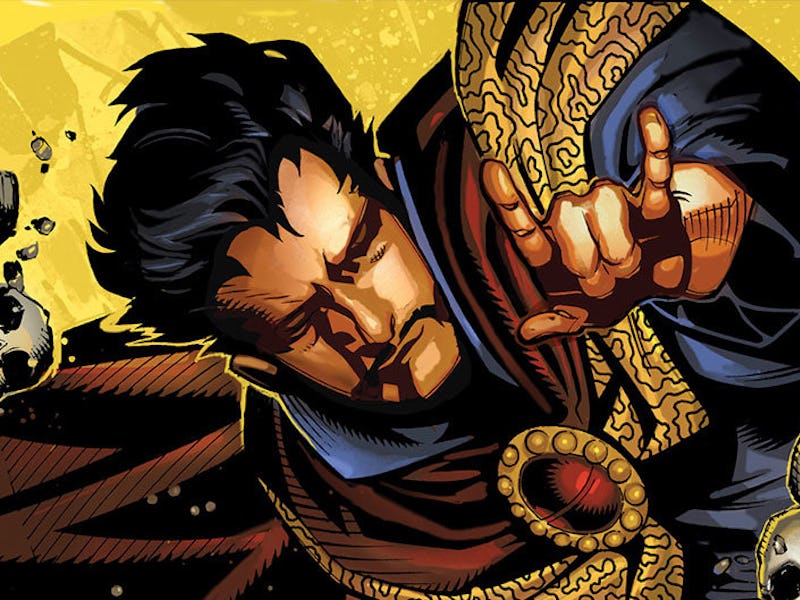Can 'Hellboy' Teach 'Doctor Strange' to Make a Heroic Horror Movie
The upcoming film about a magic surgeon could use the help of Hellboy's unique vision.

Doctor Strange director Scott Derrickson is perhaps best known for his fantastic horror film, Sinister. While the film sometimes conforms to horror genre tropes, it is, overall, a stylish, tense, and genuinely terrifying film about a demonic home invasion. Derrickson’s horror pedigree also recalls another famous horror auteur and his many forays into comic book movies.
Guillermo Del Toro, who helmed Blade II and both Hellboy movies, in many ways defined the horror superhero genre as it (barely) exists today. So what is it exactly that horror directors can bring to superhero films; and what was so radical about Hellboy that can allow Doctor Strange to pick up a few pointers? If the film wants to be as “weird” as the director expects it to be, it’s got quite a few Del Toro images to emulate.
Rewatching Hellboy, it’s surprising how accessible a film about a demon monster fighter is. Del Toro adapts a comic book with very strong religious and Gothic imagery into a surprisingly lively film about demons fighting other demons in the most visceral and exciting way possible. Still, Del Toro doesn’t compromise on either the source material or his own love of things that go bump in the night. His monster designs are decidedly not consumer friendly, and he stages his demons in genuinely terrifying, apocalyptic backgrounds. Del Toro’s Hellboy leaned more heavily on artistry than marketability.
One look at the Doctor Strange trailer, and the studio’s desire to create a film that is visually mind-bending is readily apparent. Cityscapes multiply and then collapse into each other, as Benedict Cumberbatch’s Stephen Strange has a literal out-of-body experience. It’s interesting to note how sterile lighting and muted colors are used when the film showcases the surgeon beginnings of Strange’s life, since that look quickly devolves into a golden hue once the film’s mysticism is introduced. The point being, the film at least is set to look like it’s willing to step into a new direction.
We’ve already seen ‘Inception’ and ‘The Matrix’, try monsters instead
Unfortunately, however, the biggest criticism leveled at the new Doctor Strange trailer is that some of the set-pieces shown off are reminiscent of two of the most culturally recognizable films of the past decades, Christopher Nolan’s Inception and Lana and Lily Wachowski’s The Matrix. It’s hard to expect something visually groundbreaking from a film that immediately draws comparisons to films that are already famous for being visually groundbreaking. Doctor Strange won’t ignite anyone’s imaginations if it exists inside a cultural echo chamber.
However, if you look at the 2015 Doctor Strange comics by Jason Aaron and Chris Bachalo, one can see that the new vision for Doctor Strange is rooted firmly in monsters and mystic demons, something Hellboy was able to pull off despite being an obscure property in the early 2000s. Showcasing some genuinely out-there creatures might fly even higher in today’s saturated superhero market.
Doctor Strange
Subtle horror is a good way to go
There is something very dark in the way the early parts of the trailer plays out. The scenes from the car accident, as well as the aftermath of Strange’s surgery look genuinely terrible, and there is some really terrific stuff that can be done with surgical horror that would fit right inside Derrickson’s wheelhouse.
Don’t forget mystic gadgets
Doctor Strange
Where Doctor Strange and Hellboy directly overlap is their use of mystical gadgets. Del Toro brought out a whole bunch of different toys in his Hellboy films. From weapons to mystic artifacts, to that one villain who was a blade-wielding wind-up Nazi toy, Del Toro brought a steampunk visual style to his character’s arsenal.
Doctor Strange is famous for wielding the Eye of Agamotto and the cloak of levitation. The eye is an amulet which allows Strange to see into mystic forces. The cloak is sort of self-explanatory. It’s typically illustrated as floating even when not worn by Doctor Strange. Visually, there are some cool things that can be done with the two mystical items that would make fantastic depictions on film.
Studio systems, then and now
It’s interesting to compare the two directors because the two are actually working under very different circumstances. When Del Toro was making Blade II and the Hellboy films, he was mostly beholden to the previous films in the series. Derrickson is working on a film that has to incorporate a new origin film into the ever-expanding Marvel Cinematic Universe. Even off-kilter films like Guardians of the Galaxy and Ant-Man were filled with expanded universe moments which, at this point, feel mandatory for any new Marvel film.
The comparison really comes down to the idea of “accessibility”. Hellboy, for all of its hellish imagery, was still very accessible and this was in a time way before the concept that superhero genre films could become multi-billion dollar juggernauts. Liberties were taken with the source material then which probably wouldn’t be necessary under today’s multi-film, multi-arc expanded universe.
At the same time, critical opinion now matters more than ever in making a superhero movie. As the critical trashing of Batman v Superman seems to have actually hurt the film’s financial success, it’s clear to movie makers that audiences want genuinely good films, that also impresses critics. In this day and age, weirder might actually be better.